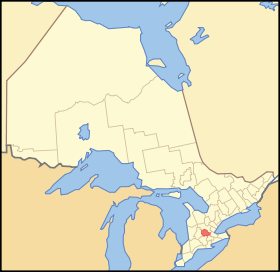Waterloo Region, Ontario
| Waterloo Region | ||
|---|---|---|
| Upper-tier regional municipality | ||
| Regional Municipality of Waterloo | ||
|
||
| Motto: "Peace, Prosperity!" | ||
 Location of Waterloo Region in Ontario |
||
| Coordinates: 43°28′N 80°30′W / 43.467°N 80.500°WCoordinates: 43°28′N 80°30′W / 43.467°N 80.500°W | ||
| Country |
|
|
| Province |
|
|
| Government | ||
| • Regional Chair | Ken Seiling | |
| • Governing Body | Waterloo Regional Council | |
| • MPs |
List of MPs
|
|
| • MPPs |
List of MPPs
|
|
| Area | ||
| • Land | 1,368.94 km2 (528.55 sq mi) | |
| Population (2016) | ||
| • Total | 535,154 | |
| • Density | 370.4/km2 (959/sq mi) | |
| Time zone | EST (UTC−5) | |
| • Summer (DST) | EDT (UTC−4) | |
| Area code(s) | (519) and (226) | |
| Website | region |
|
The Regional Municipality of Waterloo is a regional municipality located in Southern Ontario, Canada. It consists of the cities of Kitchener, Cambridge, and Waterloo (collectively called the Tri-Cities), and the townships of Wellesley, Woolwich, Wilmot, and North Dumfries. It is often referred to as the Region of Waterloo or just Waterloo Region. The Region is 1,369 square kilometres in size and its regional seat of government is in Kitchener. The second largest city is Waterloo.
The Region's population was 535,154 at the 2016 census.
The Region was preceded by Waterloo County, Ontario, created in 1853 and dissolved in 1973. That entity consisted of five townships: Woolwich, Wellesley, Wilmot, Waterloo, and North Dumfries, including the cities and towns in each area.
During the 16th and 17th centuries, the area was inhabited by the Iroquoian speaking Attawandaron nation.
Historical accounts differ on exactly how the Attawandaron tribe was wiped out, but it is generally agreed that the Seneca and the Mohawk tribes of the Six Nations destroyed or forced out the smaller Attawandaron tribe while severely crippling the Huron around 1680-85. After the invasion of the Six Nations into the Grand River Valley, the Neutral tribe ceased to have any political existence. Any dispersed survivors were taken captive or escaped to other tribes such as the Mississaugas and were assimilated into that culture. There are no distinct Attawandarons today.
...
Wikipedia

